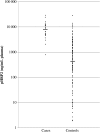Histidine-rich protein 2 plasma levels predict progression to cerebral malaria in Malawian children with Plasmodium falciparum infection
- PMID: 23630364
- PMCID: PMC3699003
- DOI: 10.1093/infdis/jit176
Histidine-rich protein 2 plasma levels predict progression to cerebral malaria in Malawian children with Plasmodium falciparum infection
Abstract
Some children with uncomplicated malaria progress to cerebral malaria despite appropriate treatment; identifying them in advance might improve their care. The objective of this study was to determine if plasma concentrations of a malaria protein, HRP2 (histidine-rich protein 2) would serve this purpose. Cases and controls were children presenting with uncomplicated malaria; the cases (n = 25) developed cerebral malaria, and the controls (n = 125) did not. Mean plasma HRP2 concentrations were significantly higher in the cases, and an HRP2 cutoff was identified that could predict disease progression (sensitivity and specificity, 88% for each). Quantitative measurements of HRP2 may be a useful screening tool.
Keywords: HRP2; cerebral malaria; malaria diagnostics.
Figures


References
-
- Murray CJ, Rosenfeld LC, Lim SS, et al. Global malaria mortality between 1980 and 2010: a systematic analysis. Lancet. 2012;379:413–31. - PubMed
-
- [No authors listed]. Severe falciparum malaria. World Health Organization, Communicable Diseases Cluster. Trans R Soc Trop Med Hyg. 2000;94(Suppl 1):S1–90. - PubMed
-
- Desakorn V, Dondorp AM, Silamut K, et al. Stage-dependent production and release of histidine-rich protein 2 by Plasmodium falciparum. Trans R Soc Trop Med Hyg. 2005;99:517–24. - PubMed
-
- Desakorn V, Silamut K, Angus B, et al. Semi-quantitative measurement of Plasmodium falciparum antigen PfHRP2 in blood and plasma. Trans R Soc Trop Med Hyg. 1997;91:479–83. - PubMed
Publication types
MeSH terms
Substances
Grants and funding
LinkOut - more resources
Full Text Sources
Other Literature Sources

